Infrastructure failure and the impact on public health services

The recent RAAC revelations have exposed deficiencies in the UK’s long-term infrastructure planning and highlight the need for structural change, writes Infrastructure Solutions Associate at Lexica, Amy Colllins.
As the academic year resumes in England after the summer break, our educational landscape finds itself under intense scrutiny, with a focus on schools that may be grappling with a structural dilemma – crumbling concrete. The culprit behind this issue is reinforced autoclaved aerated concrete (RAAC), a construction material employed in schools and various structures from the 1950s through the mid-1990s, which has, over time, disintegrated and is now at risk of collapse.
In early September, the Department for Education issued new guidelines on how to deal with RAAC in schools. This isn’t just about safety concerns when entering these buildings; it also raises worries about the disruptions it might cause to students’ learning and the retention of teachers.
This spotlight on RAAC has also made people more concerned about its presence in the NHS. On 5th September, NHS England sent a message to all Trusts and Integrated Care Boards, emphasising the importance of dealing with RAAC in the NHS estate. It outlined steps to ensure RAAC is identified and managed properly to keep patients, staff, and visitors safe. Experts from Loughborough University are now recommending regular safety checks for thousands of buildings, many of which are owned by the government. Seeing 40 RAAC-reliant hospitals and 150 schools being held up with scaffolding illustrates how infrastructure problems can seriously affect the services we rely on.
Infrastructure issues aren’t limited to RAAC – they include other problems like asbestos, floods, leaky roofs, peeling walls, electrical problems, and temperature regulation issues. The media has shown how these issues can affect the experience of patients in hospitals. NHS facilities also keep records of needed maintenance, and the bill for these overdue repairs in the healthcare sector in England alone is a startling £10.2 billion.
The need for long-term planning for our NHS buildings goes beyond just the big hospitals – primary care facilities must also be considered. Poor facilities with ongoing infrastructure problems affect healthcare delivery and service recovery, impacting patient pathways and outcomes.
In December 2022, the British Medical Association (BMA) called for immediate investment in fixing old buildings and creating better working environments for NHS staff. The BMA report stressed that outdated and poorly designed healthcare buildings make it difficult for doctors to provide safe, high-quality care. The report urged the UK Government to provide funding to address maintenance backlogs quickly or, in some cases, to rebuild sites that can no longer be adequately repaired, with the goal of protecting doctors and patients and stopping the list of repairs from growing longer.
A survey by the BMA found that 38 per cent of doctors described their workplaces as either ‘poor’ or ‘very poor’ in terms of physical conditions. This negatively affected patient care, according to 43 per cent of respondents. Doctors also complained about old, cramped, and inefficient hospital and GP practise designs, especially concerning ventilation and infection control. Limited space often means doctors don’t have suitable rest areas, places for extra staff, or private spaces for confidential patient discussions. Another BMA report expressed doctors’ frustrations with the NHS’s digital infrastructure, citing outdated, slow, and incompatible IT systems and hardware that waste staff time and risk patient safety.
The need for change isn’t just about fixing buildings and infrastructure. Effective solutions can address a range of NHS challenges, such as improving safety, service quality, environmental sustainability, staff recruitment and retention, and patient outcomes.
In the midst of crumbling buildings and infrastructure challenges, a clear message rings out: it’s time to make things better. Whether it’s in schools or healthcare, we must take action. Urgent steps are needed to ensure our buildings are safe, our professionals are well-supported, and our citizens receive quality services. The issues linked to materials like RAAC are just part of a bigger problem that needs immediate attention.
To build a brighter future for our schools, hospitals, and beyond, we must plan for the long term. It’s not just about fixing immediate problems; it’s about making life better for everyone these places serve. As the BMA’s report highlights, the state of our buildings affects patient care, staff morale, and our ability to meet the healthcare needs of the 21st century. Calls for change must be answered by long-term investments in the foundations of our hospitals and schools. In doing so, we can raise the standards of care, safety, and overall quality of life for all.
